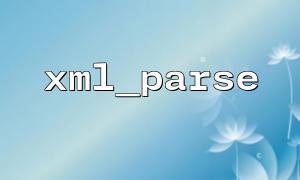In daily PHP development, we often need to obtain XML data from remote servers and parse it. This article will demonstrate how to use curl to download XML data, then parse the content in combination with the xml_parse series functions, and convert it to an available array structure.
First, make sure the following extensions are enabled in your PHP environment:
cURL : used to remotely download data
XML Parser : used to parse XML documents
These two extensions are default to most PHP installation packages that are built in and require no additional installation.
Let's first download the XML content from a remote address through cURL:
function fetchXmlData($url) {
$ch = curl_init();
curl_setopt($ch, CURLOPT_URL, $url);
curl_setopt($ch, CURLOPT_RETURNTRANSFER, true);
curl_setopt($ch, CURLOPT_TIMEOUT, 10);
$data = curl_exec($ch);
if (curl_errno($ch)) {
echo 'Curl error: ' . curl_error($ch);
return false;
}
curl_close($ch);
return $data;
}
// Example URL
$url = 'https://api.m66.net/data/sample.xml';
$xmlContent = fetchXmlData($url);
if ($xmlContent === false) {
exit('Get XML fail');
}
PHP's xml_parse function is an event-driven XML parsing method. We can convert XML content into a structured array by creating a parser and setting up processing functions.
function parseXmlToArray($xml) {
$parser = xml_parser_create();
$values = [];
$index = [];
xml_parser_set_option($parser, XML_OPTION_CASE_FOLDING, 0);
xml_parser_set_option($parser, XML_OPTION_SKIP_WHITE, 1);
if (!xml_parse_into_struct($parser, $xml, $values, $index)) {
echo "XML Parsing error: " . xml_error_string(xml_get_error_code($parser));
xml_parser_free($parser);
return false;
}
xml_parser_free($parser);
return buildXmlArray($values);
}
function buildXmlArray($values) {
$result = [];
$stack = [];
foreach ($values as $val) {
switch ($val['type']) {
case 'open':
$tag = $val['tag'];
$child = [];
if (isset($val['attributes'])) {
$child['@attributes'] = $val['attributes'];
}
$child['@children'] = [];
$stack[] = [&$result];
$result[$tag][] = &$child;
$result = &$child['@children'];
break;
case 'complete':
$tag = $val['tag'];
$entry = isset($val['value']) ? $val['value'] : '';
if (isset($val['attributes'])) {
$result[$tag][] = [
'@attributes' => $val['attributes'],
'@value' => $entry
];
} else {
$result[$tag][] = $entry;
}
break;
case 'close':
$result = &$stack[count($stack) - 1][0];
array_pop($stack);
break;
}
}
return $result;
}
By combining the above two parts, we can implement the complete "download + parsing" process:
$url = 'https://api.m66.net/data/sample.xml';
$xmlContent = fetchXmlData($url);
if ($xmlContent) {
$parsedData = parseXmlToArray($xmlContent);
echo "<pre>";
print_r($parsedData);
echo "</pre>";
}
Through this article, you have mastered how to use PHP's cURL extension to download XML data, and how to use xml_parse to parse it into a structured array. Although xml_parse is a lower-level method, it has high performance and few dependencies, making it suitable for projects with performance requirements.
If you need to deal with more complex XML, it is recommended that you try to use more advanced parsers such as SimpleXML or DOMDocument in the future.















